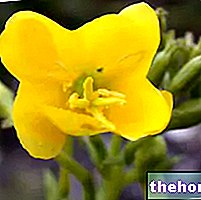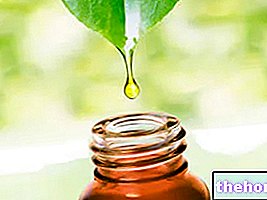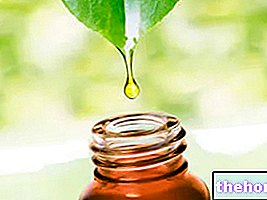Cynara scolymus L.= C. cardunculus var. scolymus
Fam. Asteraceae (Compositae)
Subfam. Tubuliflorae
Description
The artichoke is a biennial herbaceous plant probably derived from the horticultural selection of the thistle. Therefore it is not found spontaneously, but is abundantly cultivated as a vegetable.
In the first year a rosette of very elongated and deeply divided basal leaves develops; in the second, the single flower stem develops from the center of the rosette with smaller sessile leaves and at the top the large flower heads with hermaphroditic tubular flowers, with 5 blue-violet petals. The basal leaves of the artichoke are pinnate-lots 30-60 cm long and 5-10 cm broad, with prominent central rib and toothed segments devoid of thorns; those at the top of the caule are instead smaller, pinnatophid, lobed or almost whole. The fully developed leaf is green and glabrous on the upper side, while the lower one is lighter also due to the presence of long and very fine hairs.
Fruit: an achene supplied with pappus.
The smell of the artichoke is nil and the taste is very bitter.

Areal
According to some it would be a single species with two subspecies:C.scolymus, the artichoke, e C. cardunculus, the thistle. According to others, both were derived from the wild thistle, widespread in Mediterranean Europe and northern Africa, developing the flower heads, in the artichoke, the petioles and the leaves in the thistle. Already known to the Egyptians, the artichoke was consumed not only as a vegetable, but, in the Middle Ages, especially for the medicinal properties of the plant residing, rather than in the flower heads, in the leaves and stems of bitter taste, useful in liver disorders.
Culture
The artichoke wants a temperate and not humid climate, deep soil and rich in organic substance. Reproduction is done by seeds or, preferably by suckers (carducci), choosing those that have some woody roots and 3-5 leaves. The carducci are planted in holes of about 30 cm at a distance of 1m from each other. In the hole, above the fertilizer, the sucker is planted at a depth of 10 cm, then covered and bathed repeatedly. In summer, they are cut close to the soil all the stems missing flowers and in autumn all the suckers except 1-2, the most beautiful, around which the leaves are tied to protect them from the cold. In May the inflorescences that are collected begin to ripen. 3 years.
The thistle, used for the leaves, undergoes a bleaching towards the end of September-October, consisting in tying the leaves in bundles and then covering them with straw, tucking the foot well. This technique lasts 20-25 days, but can also last until December. Plants removed from the ground must be consumed immediately.
As a vegetable, the young flower heads of the artichoke are consumed, before anthesis, when they are covered by various layers of fleshy involucral bracts at the base and thorny at the apex.
The active ingredients belong to various classes of substances:
1) caffeoylquinin compounds (e.g. cynarin) 2) sesquiterpene lactones, guaianolide type, with a bitter taste (e.g. cinaropicrin) 3) flavonoid derivatives 4) Organic acids (glyceric, citric, lactic) 5) tannins, 6) organic salts of potassium and magnesium, 7) anthraquinone glucosides 8) B vitamins and beta-carotene. 9) inulin. The therapeutic activity depends on the set of substances (synergism)
Uses
In the food sector, artichokes are consumed as vegetables.
In pharmacies and herbalists, the artichoke is used as a choleretic, hepatoprotective and diuretic. In phytopharmacy the leaves are mainly used. Due to the presence of ortho-diphenols and sequiterpenic lactones, this plant is counted among the bitters, with eupeptic and stomachic functions. It is also cholesterol-lowering.
The artichoke owes its choleretic action mainly to the presence of cynarin, a bitter and aromatic substance that stimulates the secretion of bile.
Watch the video
- Watch the video on youtube
In cosmetics, artichoke is used as a skin stimulant for scalp care.
SEE ALSO: ARTICHOKES nutritional tables
Milk thistle
Select plant Fir Acacia Acerola Sorrel Yarrow Yarrow Yarrow Aconito Adatoda Garlic Agnocasto Agrimonia Alchemilla Alkekengi Aloe Altea Witch Hazel Ammi or Visnaga Pineapple Andrographis Anemone Pulsatilla Angelica Anise Star Anise Japanese Star Anise Bitter Orange Bitter Areca Arnica Harpagophytum Arpagophyte Artemisia Asteragus Basil Asparagus Asparagus Peruvian Asparagus Asparagus Asparagus Hawthorn Boldo Borage Shepherd's Purse Boswellia Bucco Butea superba Cocoa Coffee Cajeput Calamus Calamus Marigold Camedrio Chamomile Roman Chamomile Camphor Cinnamon Ceylon Maidenhair Capuchin Artichoke Cardamom Cardiac Thistle Asian Thistle Carvi Cascara Cassia Catecu Catha Cabbage Celandine Chicory Centaurea Cinnamon Cypress Celandine Chives Cypress Coca Cola Colchico Combreto Condurango Comfrey Coriander Cranberry Barberry American Chrysanthemum Cumin Turmeric Damiana Digital Dioscorea Drosera Dulcamara Dunalilella Echinacea Eder a Ephedra Elenio Eleutherococcus Helichrysum Evening primrose Horsetail Alfalfa Erica Euphrasia Erisimo Escolzia Eucalyptus Farfara Farfaraccio Calabar bean Fenugreek Fennel Phytolacca Frangola Ash Fumaria Japanese Mushrooms Galega Ganoderma lucidum Garcinia Cambogia Mulberry Gentian Broom Ginkgo Ginkgo Guipana Guipana Gynestra Ginkgo Hibelia Gymnasium Hibiscus Guarulp St. John's Wort Horse Chestnut Ispaghul Hyssop Jaborandi Kava kava Konjac Laminaria Cherry Laurel Lavender Lemongrass Lespedeza Lovage Icelandic Lichen Lemon Flax Lippia Licorice Lobelia Hops Maca Marjoram Maize Mallow Manna Marrubio Marrubio d "water Matè Melaleuca Meliloto American Lemon balm Myrtle Myrama Walnut Nutmeg Walnut vomica Olive tree Meadowsweet Ononide Opuntia Oregano Orthosiphon Nettle Poppy Papaya Parietaria Feverfew Passiflora Chilli Perilla Periwinkle Phyllanthus Plantain Picrorhiza Pilosella Pino Pisci dia Podofillo Polygala Grapefruit Parsley Psyllium Pueraria mirifica Butcher's broom Pygeum Quassia Oak Rhubarb Ratania Rauwolfia currant Castor bean Rhodiola Rosehip Rosemary Rue Willow Sarsaparilla Sage Elderberry Sassafras Sedum Ergot Senna Serenoa Repens Soybean Solidago Tansy Taraxus Tamarind Tamarind Tamarind Tamarind Tamarindo Ursina Valerian Vanilla Mullein Verbena Veronica Viburnum Vinca Pansy Mistletoe Vine Withania Yohimbe Saffron Ginger Pumpkin Select disease Juvenile Acne Rosacea Tinnitus Tinnitus Aerophagia Tendon Affections Afonia Aphthae Algias Functional Halitosis Breastfeeding Allergy Anemia Anguish Anxiety Arteriosclerosis Asthrosis Asthrosis Arthritis Arthritis Men Sex Woman Blepharitis and Conjunctivitis Eye bags Bronchitis Gallstones Kidney stones Salivary stones Baldness Androgenetic Candida Fragile hair Caries Headache Cellulitis Motion sickness Cystitis C limaterio Cholecystopathy High cholesterol Ulcerative colitis Colonoscopy Contusions Hematoma Convalescence Couperose Depression Dermatitis Diaper dermatitis Diabetes Diarrhea Erectile dysfunction Dyslipidemia Dysmenorrhea Dyspepsia Disturbances of vision Hemorrhoids Epistaxis Herethism Heart disease Fever Fibromyalgia Gastro-intestinal disease Flatulence Hypertension Fibromyalgia Gastrointomnia Jaundice Laryngitis Renal lithiasis Toothache Sore throat Thinness Menopause Meteorism Mononucleosis Alzheimer's disease Crohn's disease Nausea Vomiting Obesity Dark circles Onychomycosis Osteoporosis Dry skin Periarthritis Piorea Low pressure Prostatitis Psoriasis Colds Breast fissures Anal fissures Gastro-nasal rhinitis Senescence Premenstrual Syndrome Sinusitis Quit smoking Overweight Fatty liver Constipation Stomatitis Stress Cough Triglycerides high Ulcer Burns Nails Brittle flashes Heat Warts Dizziness Properties herbal Tanning Abortive adaptogenic Aphrodisiac bittering analgesic anesthetic anorectics analgesic antacid anti-allergic anti-asthmatic Antibiotic catarrh Anticellulitiche anticonvulsant Antidiaforetiche antidiarrheal edematous anthelmintic antiemetic Antiemorroidarie antiphlogistic Antiidrotiche Antinevrotiche Antioxidants antipyretic antirheumatic antiscorbutic Antiseptic antispasmodic anti-uric Aperitive Flavoring Astringent Balsamic Bechiche Capillarotrope Cardiotonic Carminative Cathartic Caustics Healing Cholagogues Choleretic Dyes Decongestants Deodorants Purifying Diaphoretic Cleansers Disinfectants Detoxifiers Thirst quenching Diuretics Exciting Emetics Emmenagogues Emollients Hemostatic Energies Hepatoprotectors Expectorants Eupepticus Moisturisers Galactosensitizers lanti Hypertensive Hypnotic Hypoglycemic Hypotensive Irritants Laxatives Soothing Narcotic Nerves Nutrients Odontalgic Pectoral Purgative Revulsive Remineralizing Refreshing Rubefacient Scialagoghe Sedative Soporifugas Sneezing Stomachic Stomatics Narcotic Vascular Tightenitis




























